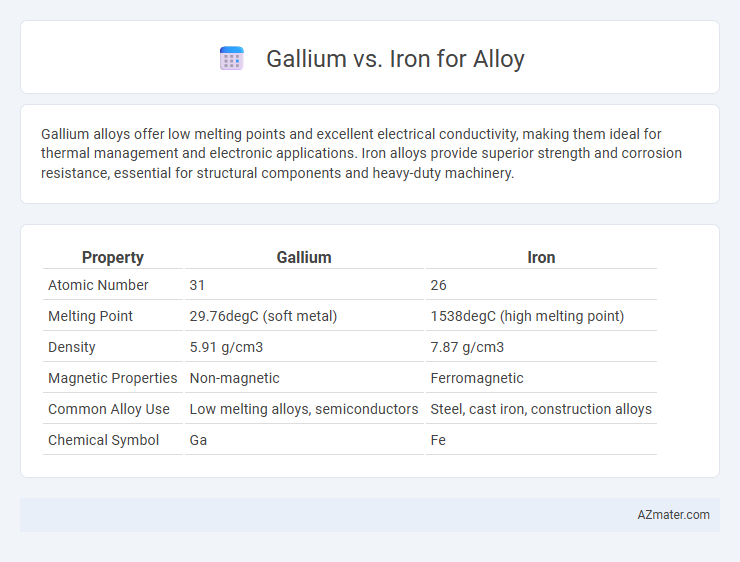Gallium alloys offer low melting points and excellent electrical conductivity, making them ideal for thermal management and electronic applications. Iron alloys provide superior strength and corrosion resistance, essential for structural components and heavy-duty machinery.
Table of Comparison
| Property | Gallium | Iron |
|---|---|---|
| Atomic Number | 31 | 26 |
| Melting Point | 29.76degC (soft metal) | 1538degC (high melting point) |
| Density | 5.91 g/cm3 | 7.87 g/cm3 |
| Magnetic Properties | Non-magnetic | Ferromagnetic |
| Common Alloy Use | Low melting alloys, semiconductors | Steel, cast iron, construction alloys |
| Chemical Symbol | Ga | Fe |
Introduction to Gallium and Iron in Alloys
Gallium is a soft, low-melting metal often used in alloys to improve fluidity and reduce melting points, making it valuable in electronics and specialized applications. Iron, a strong and abundant metal, forms the backbone of many alloys such as steel, providing hardness, tensile strength, and durability. Combining gallium with iron in alloys can enhance machinability and corrosion resistance while optimizing thermal and electrical properties.
Atomic Structure and Properties Comparison
Gallium and iron differ significantly in atomic structure, with gallium having an atomic number of 31 and a unique orthorhombic crystal structure, while iron, atomic number 26, adopts a body-centered cubic lattice at room temperature that transitions to face-centered cubic at higher temperatures. Gallium's low melting point of 29.76degC and high electrical conductivity contrast sharply with iron's high melting point of 1538degC and magnetic properties essential for alloy strength and durability. These atomic and physical differences influence alloy behavior, where gallium enhances malleability and corrosion resistance, and iron contributes strength, hardness, and magnetic properties for structural applications.
Melting Points: Gallium vs Iron
Gallium has a melting point of approximately 29.76degC (85.57degF), significantly lower than iron's melting point of about 1538degC (2800degF), making gallium ideal for applications requiring low-temperature melting alloys. The stark contrast in melting points between gallium and iron allows for creating specialized alloys with tailored thermal properties, such as fusible alloys that melt near room temperature. This difference also impacts alloy processing methods, where gallium-based alloys can be cast or molded with minimal heat energy compared to iron-based alloys.
Alloy Formation Capabilities
Gallium demonstrates a unique ability to form low-melting alloys, such as with aluminum, enhancing malleability and corrosion resistance, whereas iron primarily forms strong, durable alloys like steel by combining with carbon and other elements to increase hardness and tensile strength. Gallium's low melting point and liquid state near room temperature enable it to act as a binding agent in alloys, facilitating novel material properties not achievable with iron-based alloys. Iron alloys, especially steels, are essential in structural applications due to their robustness, while gallium alloys excel in specialized electronic and low-temperature applications.
Mechanical Strength in Gallium and Iron Alloys
Iron alloys exhibit significantly higher mechanical strength compared to gallium alloys, making them ideal for structural applications requiring durability and load-bearing capacity. Gallium alloys, such as gallium-based liquid metals, display lower mechanical strength but offer superior flexibility and corrosion resistance, beneficial in specialized electronic and thermal interface materials. The intrinsic atomic bonding and crystalline structure of iron contribute to its robust tensile strength, whereas gallium's weak metallic bonds result in softer, more malleable alloys.
Corrosion Resistance Differences
Gallium alloys exhibit significantly higher corrosion resistance compared to iron-based alloys due to gallium's ability to form stable, protective oxide layers that inhibit oxidation and degradation in harsh environments. Iron alloys are prone to rust and corrosion when exposed to moisture and oxygen, especially in the presence of salts or acidic conditions, leading to structural weakening over time. The unique chemical properties of gallium-based alloys make them more suitable for applications requiring long-term durability and resistance to corrosive agents.
Industrial Applications of Gallium and Iron Alloys
Gallium alloys excel in semiconductor and electronic applications due to gallium's excellent electrical conductivity and low melting point, enabling precise component manufacturing such as gallium arsenide in integrated circuits and solar cells. Iron alloys, especially steels, dominate construction, automotive, and machinery industries owing to their superior strength, durability, and cost-effectiveness. Industrial use of gallium alloys often targets high-tech fields requiring lightweight and corrosion-resistant materials, while iron alloys provide foundational structural support across diverse heavy industries.
Cost and Availability Analysis
Gallium is significantly more expensive than iron due to its rarity and complex extraction process, impacting the overall cost of gallium-based alloys. Iron remains abundant and widely available, making iron alloys far more cost-effective for large-scale industrial applications. The scarcity of gallium limits its use primarily to specialized alloys requiring unique properties like low melting points or semiconducting abilities, whereas iron's availability supports diverse alloy formulations in construction, automotive, and manufacturing sectors.
Environmental Impact and Sustainability
Gallium alloys offer significant environmental benefits compared to traditional iron alloys due to their lower melting points, which reduce energy consumption during processing and manufacturing. Iron mining and smelting contribute substantially to greenhouse gas emissions and habitat disruption, whereas gallium, often recovered as a byproduct of aluminum and zinc production, leverages existing resources with less environmental degradation. The increased recyclability of gallium-based alloys further enhances their sustainability profile by minimizing waste and reducing the demand for raw material extraction.
Future Prospects in Metallurgy
Gallium's low melting point and unique liquid metal properties offer innovative applications in next-generation alloys, enhancing adaptability in flexible electronics and advanced cooling systems. Iron remains critical due to its abundant availability and superior strength, but integrating gallium can improve ductility and corrosion resistance in steel-based alloys. Future metallurgical research targets gallium-iron composites to create lightweight, high-performance materials for aerospace and advanced manufacturing sectors.

Infographic: Gallium vs Iron for Alloy
 azmater.com
azmater.com